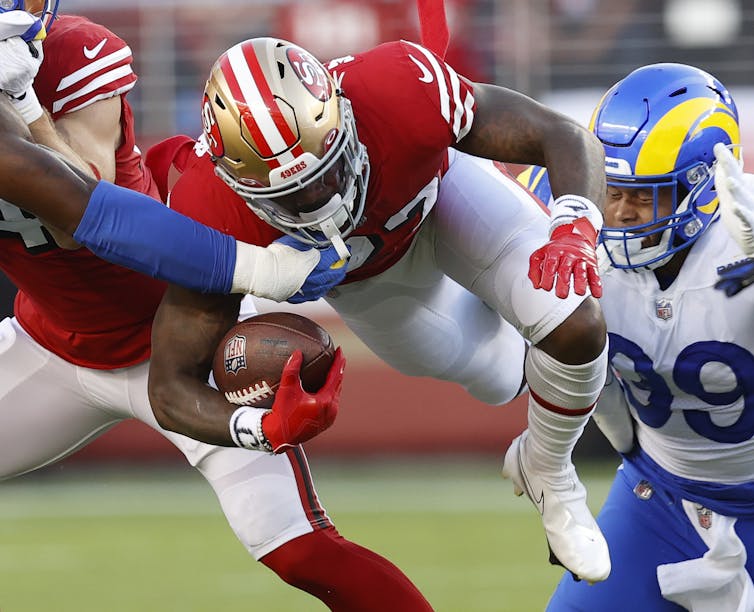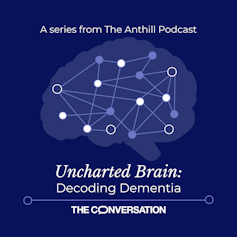BU’s Dr Keith Parry contributes to this article from The Conversation, sharing the experiences of family members of those with brain injuries as a result of sport…
Sport-induced traumatic brain injury: families reveal the ‘hell’ of living with the condition

EPA-EFE/JOHN G. MABANGLO
Matthew Smith, University of Winchester; Adam John White, Oxford Brookes University, and Keith Parry, Bournemouth University
This article is part of the Insights Uncharted Brain series.
Jill* looked drained as we sat down to speak about her late husband. It had been a long day. It was February 2020, and we had been conducting interviews at the Concussion Legacy Foundation family huddle.
Despite being tired, Jill, 47, was keen to be interviewed. She wanted to share what she had gone through and hoped her story might help others. We sat down in a quiet corner of the foyer of the Rosen Centre hotel in Orlando, Florida, and I listened to her speak for over 90 minutes.
You can listen to more articles from The Conversation, narrated by Noa, here.
She told me all about her husband, Michael, a larger-than-life character who was the “life and soul of the party”. She spoke about how he had played many sports and had experienced multiple diagnosed concussions playing American Football and lacrosse – but this never dimmed his enthusiasm for sports.
Jill described how his behaviour gradually changed. How he forgot simple tasks. How he became aggressive. How his behaviour had become so erratic, she didn’t feel they were welcome at social events anymore. She said:
You’re just watching somebody you love disappear before your eyes and it’s hell.
Then one day she was on the phone to her husband while he was at work and the call went quiet. Jill rushed to his office, only to find that he had taken his own life.
Jill was one of the 23 interviews we conducted with family members over the three days our research team spent at the Concussion Legacy Foundation event. Our conversations provided an insight into what it was like living with a former athlete with chronic traumatic encephalopathy (CTE), a neurodegenerative disease similar to Alzheimer’s that has been caused by repetitive head impacts in contexts like sport and the military.

This story is part of Conversation Insights
The Insights team generates long-form journalism and is working with academics from different backgrounds who have been engaged in projects to tackle societal and scientific challenges.
The people we spoke to had been through so much. The confusion, hurt and despair of seeing the mind of someone they love gradually deteriorate seemed overwhelming. But we also saw some positive signs, such as how they wanted to share their stories to help others, and how there appeared to be a shared determination to change things for the better and to make sport safer so other families wouldn’t have to go through what they’d experienced.
Head injuries in sport
Chronic traumatic brain injury associated with boxing has been known about for around 100 years. In 1928, Harrison Martland first described chronic traumatic encephalopathy in retired boxers. It was first referred to as “punch-drunk syndrome” or “dementia pugilistica” and sometimes develops in boxers as a result of long-term sub-clinical concussions (not detectable by the usual clinical tests).
In 2002, neuropathologist Bennet Omalu examined the brain of Mike Webster, a former National Football League (NFL) player who died from a heart attack after his physical and mental health had rapidly deteriorated. Subsequently, former NFL players sued the league, claiming that they had received head trauma or injuries during their football careers, which caused them long-term neurological problems.
The VA-BU-CLF UNITE Brain Bank at Boston University is the largest tissue repository in the world focused on traumatic brain injury (TBI). In a 2017 study into the first 202 donated brains, high rates of CTE were found, with 177 diagnosed with CTE, including 110 of 111 from the NFL players (99%). The brain bank now has over 1,000 brains from donors as young as 14 who have been exposed to brain traumas, primarily from playing sport. Studying these brains is crucial, not only for preventing, diagnosing and treating CTE, but also understanding the long-term consequences of concussion and traumatic brain injury.
Subsequent research from Boston University’s CTE Center in 2019 found that every year of playing full tackle American football increases the risk of developing CTE by 30%. So for every 2.6 years of playing, the risk of developing CTE doubles.
But the problem is not isolated to American sports. Compared with most other sports, rugby union has a relatively high injury rate, including at school level in the UK where it is often a compulsory sport. In addition, it has been reported that there is about one brain injury per match in international rugby.
Demise of England’s ‘lions’
In football, concussion often results from accidental head impacts (like head-to-head collisions or collisions with the goalposts). But a growing number of studies have shown that detrimental sub-concussive impacts (a bump, blow or jolt to the head that does not cause symptoms) may result from repeatedly heading the ball. And there have been an increasing number of high-profile examples in recent years who have been raising awareness of this issue.
In late 2020, three incidents shifted attitudes on the dangers of football. First, Norbert “Nobby” Stiles, a member of England’s 1966 Fifa World Cup winning team, died. Stiles had been diagnosed with dementia and the cause of this disease was linked to repeated heading of the ball in his career.
Then, it was announced that Sir Bobby Charlton, another World Cup winning hero, had also been diagnosed with dementia. He was the second member of his family to suffer with this disease as his brother, Jack (who played in the same winning team) had died earlier in the year after his own battle with dementia.
Bobby Charlton was thus the fifth of the 11 starting players in the 1966 final to have been diagnosed with neurological diseases. Media reports have linked all of these cases to the repeated heading of footballs during their playing careers.
But the first case that drew attention to the link between football and traumatic brain injury was that of Jeff Astle. Following his death in 2002, the coroner’s verdict at the inquest into his death at the age of 59 recorded a verdict of “death by industrial disease”, linked to heading heavy, often rain-sodden, leather footballs. Astle’s health had deteriorated – he had struggled with an eating disorder and was unable to recognise his children.
Astle’s daughter, Dawn, has become a leading figure in the campaign to protect footballers. She presented evidence to the 2020 DCMS committee on concussion and brain injury in sport. Her submission to the committee included the following comment:
My dad choked to death in front of me, my mum and my sisters. Please think about that for one minute. He choked to death because his brain had been destroyed. Destroyed because he was a footballer. I don’t want any other family to go through what my family went through, and continue to go through every day. Please don’t let my dad’s death and all the other footballers deaths be in vain. My dad was my hero and my best friend. His death will haunt me forever.
Families speak out
In February 2020, our team of five researchers were invited by Chris Nowinski, the CEO of the Concussion Legacy Foundation, to Orlando. The CLF is an international non-profit organisation that aims to support athletes affected by head injury, and to assist patients and families by providing personalised help to those struggling with the outcomes of brain injury.
Our interviews were conducted at their “family huddle”, which was a support event for family members to allow them to share stories and connect with others who have had similar experiences.
We were given the opportunity to talk to family members, and build trust and rapport. This gave us a greater insight and understanding of their world. We conducted interviews with the partners, parents, siblings and the children of the deceased athletes.
Our research, published in The Qualitative Report, was presented as an ethnodrama (playscript) to best allow the stories of the family members to be heard. This also showed the distinct temporal phases that these family members went through, and by sharing these stories we hope this raises awareness of the powerful emotions they have experienced.

This article is accompanied by a podcast series called Uncharted Brain: Decoding Dementia which examines new research unlocking clues to the ongoing mystery of how dementia works in the brain. Listen to the full series via The Anthill podcast.
Disbelief and confusion
Many of the people we spoke to said the initial stage, when they started to see changes in the behaviour of their loved one, created very strong emotions because they couldn’t understand why this was happening. They had seen someone they loved decline in front of their eyes. Alice, 68, reflected on seeing this change in her husband: “He went from functioning perfectly, to struggling to remember or do anything he was so used to doing.”
People went on to recall specific instances when this behavioural decline became noticeable. For example, David told us this about his brother: “Once when he went to the airport to pick up my aunt. He proceeded to drive her around, and she finally said, ‘Where are we going?’” He replied that he didn’t know.
There was evidence of a mounting feeling of hopelessness that declines in neurological functioning were causing. Another striking, distressing example was this story Sophie told about her husband:
One weekend, I had 12 big black trash bags to go out to the garbage. And I told him when I got up and went to work on Monday morning, I said, ‘those are going out to the trash tomorrow’. I came home after work and he had unpacked every trash bag … I just sat there and cried … I’d worked a 12-hour day. I said, ‘why did you unpack all that trash?’ and he couldn’t tell me why. He just didn’t know.
Others reinforced other emotions at seeing this happening to their loved one. Emily explained how she felt: “I do think at the start you are in this sense of disbelief because the person you love is doing these things that are out of character.” And Evelyn reflected on the sadness of seeing such changes:
I was shocked, but also felt like the world had been turned upside down. We were so happy. I remember just sobbing.
Researchers have previously highlighted the emotional consequences that family members experience when they witness the decline of their loved one. For example, one 2019 study involving interviews with 20 wives of either current or retired professional American football players, revealed their serious concerns about the cognitive, emotional and behavioural decline of these players. Some wives identified behavioural changes that included rage, reduced positive social interactions and various erratic behaviour, like starting risky business ventures.
As we also found, deterioration in cognitive functioning meant that those affected by traumatic brain injury were no longer able to carry out simple household tasks and often struggled with language problems.
Anger, guilt and fear
Another study, which examined families who have experienced a severe traumatic brain injury outside of sport highlighted the difficulties caused by the uncertainty of the situation – both in terms of the progression of the illness and how to support and deal with the cognitive, physical and behavioural changes exhibited after the injury.
All of this presents huge challenges to families. Negotiating appropriate treatment is hard and the emotional and physical exhaustion of dealing with these difficulties just keeps mounting up for the people involved.
Our participants explained the toll it took on them as they saw first-hand the severe changes in behaviour as their loved one experienced further decline. For example, Katherine said she felt drained and responsible. “It’s hard because you don’t know what’s happening,” she said. “So you just blame yourself and think you are the reason. And that’s not good for your own wellbeing.”
Helen spoke about her intense feelings as her partner drank as a response to his condition:
I was so angry at him for making the same choices over and over with drinking though. Like, “you’ve drank so much that you fell down the stairs in front of me at home, are you kidding me?” And it hurt, you know, and left a lot on my plate, so I was really, really, angry. And that didn’t help things.
Changes in behaviour created further problems for family members, such as how their loved one was perceived in social situations. Elizabeth described one specific incident at a party:
We went to a catered event, and he would take the top of the [burger] bun off, take the meat out to eat, put the bun back, and then go to the next one. And someone caught him and was like, “what is he doing?” Of course, we never got invited back to any of those people’s homes. No one wanted to have anything to do with him because they couldn’t understand him.
Laura also spoke about the implications of a lack of understanding of this condition, highlighting how others would misinterpret her husband’s actions. This led to feelings of sadness as they became socially isolated from their friends. She said: “When we went to events, a lot of people thought he was an alcoholic, because he could have one cocktail and then he’d fall. They had no idea that the falling had nothing to do with that one drink that he had. And it became very sad because people didn’t want to have us around.”
Our participants also spoke of the burden as a result of effectively becoming their partner’s primary caregiver. Sophie spoke about the struggles she faced with supporting her husband with daily tasks. “I couldn’t physically handle him,” she said. “At that point he was unstable. He would shuffle, and fall, and he couldn’t get in and out of the shower. He was also incontinent, and I couldn’t handle him by myself. I felt so weak.”
Evelyn also spoke of these experiences, highlighting that the physical size of her partner caused significant strain. “The sheer problem with these guys was their physical size. As the disease progressed, he fell probably 10-15 times a day, and we’d have to figure out how to get him up. I was both physically and mentally exhausted,” Evelyn said.
Meanwhile, others spoke of the physical fear of danger they felt. Like Emily who told us:
I did become scared of him. I hate to say that, but I did. He made me sign some papers and I had no idea what they were. He was just escalating and escalating, and he was standing over me and I just knew if I didn’t sign that paper, I was in physical danger. Which was an awful thought to have about your own husband that you love.
Moving forward
Our interviews gave family members the chance to reflect on their time living with and caring for their loved one, and also, how they might approach the situation differently. Helen told us she wished she had taken more time for herself, and advised anybody going through a similar situation to “get into therapy, to help you process everything and to let you have an outlet”.
Katherine agreed, saying: “You’ve got to try and take some time for yourself. I remember I took a trip with a girlfriend once and I was scared to death the whole time I was gone, but I went, and we had a wonderful time, and I’m so glad I did it. You know, trying to keep some semblance of normalcy in your life for yourself, for your own good. Try to keep yourself healthy, eat healthily, work out. Keep yourself well because there really was nothing, I could do for him except be present. I couldn’t make him well.”
Other family members reflected on the dangers of certain sports. For example, Alice highlighted how her awareness had increased, giving her the knowledge and understanding to allow her to come to terms with her husband’s situation. She realised there were “significant pathologies” that he had no control over that affected his decision-making.
His brain was still functioning, and he was still able to make decisions, just the wrong parts of the brain were directing his decisions. That totally makes sense now, so that’s been a huge relief, that he wasn’t just an asshole in his own right, he really just couldn’t control it.
While our data contained accounts full of sadness, participants also reflected on different ways they were moving forwards in a positive way after experiencing the death of a loved one. Laura detailed the benefits of attending the huddle and being with people who had been through similar struggles: “Everyone here is in the same boat. It may not have looked exactly the same for us, but we don’t have to explain for once. And just the support I’ve got from the people here has been great.”
Others talked about how the support helped the grieving process and inspired them to get involved and help other families. For example, Evelyn spoke of the need to make changes at a junior sport level: “I’m just so concerned this horrible disease is hitting younger and younger people, yet no one knows about it … giving people the information to be able to make the correct decision is super important.”
The final word goes to Elizabeth, who had become involved in the support work of the CLF, and spoke of her new found purpose to help others. She said it helped make her loss “bearable” because “millions” might benefit and “hopefully not have to experience the kind of tragedy that affected our family”.
I feel like part of the reason this happened is for me to be part of raising more awareness and be a part of this movement towards new culture change. I can help families navigate … the difficult waters of dealing with this. And so, I feel like it speaks to sort of a calling … I have in life or part of my purpose.
Consequences
What is clear to us after concluding this research project is that greater recognition of the challenges faced by both those living with diseases of the brain, such as CTE, and their carers is needed.
We heard about the devastating losses and tragedies. But we were also privileged to highlight more positive stories that showed how people were able to move forwards and help others to create a constructive change in sport so others won’t have to suffer.
It also illustrates how neurodegenerative disease resulting from head trauma as a consequence of impact sports has far reaching effects – not only the athletes, but also those around them. This represents a growing public health concern and societal problem.
It shows that greater recognition of the challenges faced by both those living with diseases of the brain, such as CTE, and their carers, is needed.
We hope their stories will stimulate discussion and be used to support people who might be going through similar experiences. Our findings might be used to help practitioners, sporting governing bodies and charities such as the CLF, to understand more fully these negative emotional responses and, in turn, consider strategies that might be developed to support people. In turn, these organisations must also act to address the causes of head injuries to make sports safer.
All names in this article have been changed to protect the anonymity of those involved.

For you: more from our Insights series:
- Climate scientists: concept of net zero is a dangerous trap
- Sexual exploitation by UN peacekeepers in DRC: fatherless children speak for first time about the pain of being abandoned
- The public cost of private schools: rising fees and luxury facilities raise questions about charitable status
To hear about new Insights articles, join the hundreds of thousands of people who value The Conversation’s evidence-based news. Subscribe to our newsletter.![]()
Matthew Smith, Senior Lecturer in Sport and Exercise Psychology, University of Winchester; Adam John White, Lecturer, Oxford Brookes University, and Keith Parry, Deputy Head Of Department in Department of Sport & Event Management, Bournemouth University
This article is republished from The Conversation under a Creative Commons license. Read the original article.
 HRV and Traumatic Injury- systematic review protocol published in PloS One by MSPH researcher
HRV and Traumatic Injury- systematic review protocol published in PloS One by MSPH researcher Conversation article – Tackling in children’s rugby must be banned to curb dementia risks
Conversation article – Tackling in children’s rugby must be banned to curb dementia risks










 Dr. Ashraf cited on ‘Modest Fashion’ in The Guardian
Dr. Ashraf cited on ‘Modest Fashion’ in The Guardian NIHR-funded research launches website
NIHR-funded research launches website Academics write for newspaper in Nepal
Academics write for newspaper in Nepal New paper published on disability in women & girls
New paper published on disability in women & girls Global Consortium for Public Health Research 2025
Global Consortium for Public Health Research 2025 MSCA Postdoctoral Fellowships 2025 Call
MSCA Postdoctoral Fellowships 2025 Call ERC Advanced Grant 2025 Webinar
ERC Advanced Grant 2025 Webinar Horizon Europe Work Programme 2025 Published
Horizon Europe Work Programme 2025 Published Horizon Europe 2025 Work Programme pre-Published
Horizon Europe 2025 Work Programme pre-Published Update on UKRO services
Update on UKRO services European research project exploring use of ‘virtual twins’ to better manage metabolic associated fatty liver disease
European research project exploring use of ‘virtual twins’ to better manage metabolic associated fatty liver disease